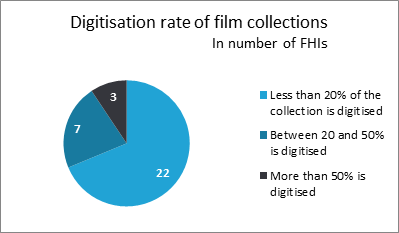On the occasion of the opening of the Cinema Ritrovato festival – one of the major events for cinephiles across the world taking place every year in Bologna, Italy - the European Audiovisual Observatory has just released a new study on the access to film works contained in Europe’s Film Heritage Institutions and collections in the context of education and research.
Key findings of this report
- Digitisation is key: the availability of films in digital formats opens up new opportunities for access to films. However, digitisation rates are still low: only 15% of all film works in the collections of Film Heritage Institutions (FHIs) are available in digital format (16% for feature films).
Digitisation rate of film collections - out of 32 Europan film archives which took place in the survey

Source: European Audiovisual Observatory
- The vast majority (76%) of films in the collections of FHIs are under copyright. However, assessing the copyright status of a film as well as identifying the rightsholders might be challenging due to the lack of centralised sources of information on rights.
- 60% of the feature films under copyright are either orphaned works or out-of-commerce.
Online access seems to be an efficient way to improve the access to film collections and expand the audiences but FHIs face legal limitations or uncertainty on how to grant this.
Drawing on the results of a survey targeting the members of the ACE (Association des Cinemathèques Européennes), the report seeks to assess the volume of film works in the collections of European Film Heritage Institutions that are accessible for research and educational purposes, considering both consultations by individual researchers and screenings organised within school or university activities. The study aims at assessing both the demand for films and the extent to which Film Heritage Institutions are able to meet this demand, while pinpointing existing practices and arrangements in the access to films.
The publication also identifies crucial aspects and challenges, touching upon issues such as rights clearance of film works for educational purposes and highlighting the role of digitisation in improving access to films. Finally, the study explores key topics such as the copyright status of the films in the collections, with special attention to orphan and out-of-commerce works.
This study is the second part of a broader research project on Film heritage, financed by the European Commission. The first phase of the project – The Exploitation of Film Heritage Works in the Digital Era – aimed at investigating the commercial value of film heritage works, assessing their performances across the different distribution channels (cinemas, TV channels, DVD, VOD). The first report can be downloaded here. This first study sets out in particular to assess the presence of European film heritage works on VOD catalogues and what visibility these films actually receive online.
The main hurdles faced by European film heritage, this first study finds, are similar to the challenges applicable to European arthouse works:
- Film heritage is becoming an increasingly niche market.
- European film heritage films tend to circulate less widely than films in general and less than US film heritage works, also due to cultural and linguistic fragmentation.
- Film heritage needs strong promotional support to successfully compete with more recent content. Theatrical re-releases can be key in boosting visibility.
- VOD is not yet a sustainable stand-alone distribution outlet and needs to be part of a broader, multi-channel distribution strategy in order to maximise the promotional outcome.